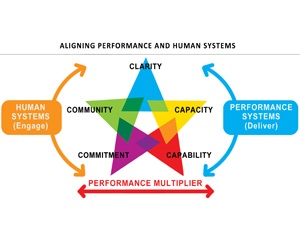The Solution Lies In Systematic Logic
Most of us want to work for successful organizations in a productive, healthy work environment, lead by great leaders. Is this too much to ask for? I really don't think so, but it still eludes most. And, how do I know this?
Over a period of over 30 years, I interviewed thousands of people working for hundreds of companies across a range of sectors from all over the world. For the purposes of this article, two questions that I asked are pertinent, namely:
- Tell me about your current working environment. What do you like and what don't you like? And, give me some concrete examples to help me understand why you feel like you do, both positively and negatively.
- Tell me about the person you currently report to and the people you work with. What do you like and what worries you? And, give me some concrete examples to help me understand why you feel like you do, both positively and negatively.
In grouping and factor analyzing answers to both sets of questions, it became apparent that there was consistency in responses regardless of the differences in the types of organization, the positions held, or the diversity of the people that I interviewed.
In a nutshell, what interviewees liked about the organizations and the people that they worked with and for could be grouped into 2 broad categories, namely: those that made organizations and people effective; and, those that made organizations great places to work, having great people to work with/for. The converse also held true in terms of what diluted effectiveness and greatness. It also became apparent to me that people valued organizations that had a Clarity of Purpose, which met (in my words) "Aristotle's criteria of logos, ethos, and pathos."
It became obvious to me that, from an organizational perspective, there were 2 systems at play, namely performance/operational systems and human systems. The factors that influenced what people felt about ineffectiveness terms were performance/operational system-related and those that they felt about in greatness terms related to human systems. It also became apparent that the "assets and liabilities" (what people liked and did not like, respectively) that defined the overall effectiveness of the performance/operational systems were tangible whilst those that defined the greatness of the human systems seemed intangible.
When I started building positive and negative anchors to help me understand what I was observing, it became clear that the constructs of both the tangible and the seemingly intangible assets could be described and measured in concrete terms.
In doing this analysis, the concept of organizational culture was not particularly useful in understanding the constructs behind what people described positively or negatively. Also, amongst other things, diversity, inclusion, and equity have remained organizational health issues for which efficacious solutions have yet to be found. Further, it became apparent that any potential solution needed to take into account the changed nature of organizations as well as the changed nature of human connectivity.
Where Did The Concept Of Organizational Culture Come From?
The origin of the concept of organizational culture is generally attributed to Dr. Elliot Jaques. In fact, he is recognized for publishing the first book on the topic, The Changing Culture of a Factory (Jaques, 1951). The question we need to ask ourselves is whether Jaques "borrowed" the wrong concept from the social sciences and applied it inappropriately to organizational/industrial psychology? If he did, he thereby presented us with a proverbial "white elephant," one which we have been unsuccessfully trying to digest for the past 70 years.
Evidence indicates that for most organizations, the achievement of an ideal culture is simply a holy grail, an allure that many organizations have paid consultants handsomely for prophylactic solutions. Ones that have simply passed through their dysfunctional systems. After the treatment, the "band-aid" type solutions wash off the wounds, which continue to fester. And then, employees become more cynical and less inclined to believe in the efficacy of future "treatments." Sound familiar?
The questioning of the usefulness of the concept of organizational culture is even more relevant given the many debates that are so topical today, ones that have been non-conclusive for decades, even more so given the global nature of organizations and the diverse, increasingly remote workforces as well as the way and degree to which people connect.
Is There An Alternative?
The starting point is to put "food for thought" on the table by redefining an organization as: "an open-ended community of people formally assembled to work together to achieve a common purpose.”
Add to this the fact that workforces are fluid and diverse, with many people working remotely and increasingly working/interacting in more than one organization at a time. Also, given WWW and social media, employees have more contact (during their workday) with outside influences on their "thinking, ideas, customs and behaviors" than with their leaders or colleagues within any particular organization.
It seems apparent that we have no option but to find a workable alternative to the concept of organizational culture or to try to turn people into cultural chameleons. People are adaptable, but they cannot become cultural chameleons.
Over time and with much analysis (sometimes paralysis), it became clear that the tangible assets of the performance/operational systems received, on balance, appropriate attention from executive groups. The rationale is simple as the two performance/operational system dimensions, being Capacity and Capability, are relatively easy to measure, as they can be defined in concrete terms. Also, the outcome of any investment of time and effort can be assessed in terms of "bang for buck," in the short and long term.
Interestingly, the seemingly intangible things (which receive less attention from executive groups) that people feel make organizations great places to work in, can be defined in terms of two major dimensions that make up the human systems aspect of an organization. These are "sense of Community" and "Commitment." Further investigation revealed that the concept of "sense of Community" has been very well researched and provides real insight into understanding important constructs that influence organizational health and performance. And, when coupled with the concept of "Commitment," an opportunity is provided to build a systems model that is inclusive of all best practices.
The challenge then was to build a model to assist leaders to systematically work with their people to make their organizations great places to work for all, with people who are great people to work with, and with leaders who are great to be led by. The model needed to be open-ended and inclusive of all recognized best practices, but specifically also needed to take cognizance of the definition of an organization put forward earlier, to recap: An organization is "an open-ended community of people formally assembled to work together to achieve a common purpose.”
In relation to the above definition, it is important to take the following into account. Organizations that contract (employ or grant membership to) are different from other communities in that membership is Conditional. It serves no purpose to avoid this critical discussion. To believe that commitment is implied in the acceptance of a job offer (together with a job title, job description, and a position in the organization structure) would be naive. This simply grants membership. Commitment is fundamental to any relationship working (and being sustainable). Therefore, entrance and tenure must be conditional on a commitment to using and continually developing the capabilities and attributes that any person is employed for to contribute fully to the organization's Purpose. Equally important, commitment to being a good organizational community member and person to work with must be non-negotiable conditions of entry into and tenure with the organization.
So with all of the above in mind, the challenge was to build a holistic, inclusive model and a process that could guide leaders to involve all of their employees in creating an organization that is "a great place to work for all, with great people to work for, led by great leaders in a productive, healthy, high-performance work environment."
So What Does This Model Look Like?
Research abounds around the superior, long-term performance of organizations with clear, higher Purpose. In the model below, Clarity of Purpose (and its constructs) aligns the performance/operational delivery systems (the dimensions and constructs of which are often described in tangible asset terms) and the human engagement systems (the dimensions of which are often described in intangible asset terms) to work in synch to optimize sustainable organizational health and performance. The first diagram below shows the systems model, whilst the second shows the constructs of the dimensions making up the systems:
 Figure 1
Figure 1
 Figure 2
Figure 2
All of the above dimensions and their constructs can be measured and developed accordingly. A detailed understanding of the model will inform that the dimensions (and their constructs) of the performance/operational systems are important in institutionalizing the outcomes of human endeavor. As such, it is the entire system that will deliver what some will continue to describe aspects of in "ideal organizational culture" terms.
In applying the above, there are some caveats. Firstly, we need to understand organizations as open-ended systems. This means that the entire system and its working parts must be understood and treated holistically. Secondly, everyone in the system needs to be included and involved in the development of the health and effectiveness of the entire system. This includes an ongoing commitment to evolving the overall organization system to remain relevant, healthy, and capable of high performance.
The following article explains how leaders can use LMS technology to involve every employee in the assessment of the status quo of organizational health and performance, and then to involve them in the resolution of issues and capitalizing of opportunities: "Leaders: Listen To The Digital Heartbeat™ Of Your Organization."
Further, in the article below, leaders can get to understand the full range of capabilities that need to be developed in all employees to support the sustainable health and performance of their organization, as well as to measure and develop these using LMS technology: "To Survive And Prosper: The Complete Capability Set Imperative."
Finally, the article "Ready, Steady, Go! Or Not?" covers a case study of one leader who is implementing this thinking into her organization to move forward confidently and positively, with all staff involved and taking responsibility for the future health and performance of the organization, as well as each other
In The End
The question posed in the title of this article was a valid one prior to the onslaught of COVID-19. However, given where organizations find themselves now, it is a question that leaders must ask themselves.
In the end, the question posed will have to be answered honestly. A more fruitful approach to building and maintaining sustainable, happy, healthy, high-performance organizations (for everyone to benefit from) needs to be adopted.
I hope that this article has presented food for thought, that is easily digestible!

